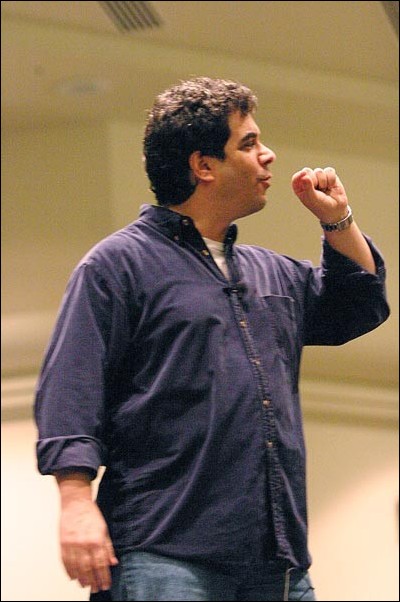Recovering alcoholic helps with awareness
Image: Recovering alcoholic helps with awareness :Once a drug user, Randy Haveson talks to Sacramento State students about how alcohol, marijuana and cocaine lead him down the path of self-distruction during Alcohol Awareness Week. Photo by Andrew Nixon/State Hornet:
October 31, 2005
Randy Haveson said he loves alcohol.
Haveson said he still remembers how it feels when he drinks it – the tingling sensation that starts in his toes and works its way to his head. He said he remembers how it pushed him out on the dance floor and enabled him to talk to beautiful women.
Despite his love affair with alcohol, marijuana and cocaine, Haveson said he celebrated 21 years of sobriety in May. Haveson said he stopped doing drugs when he realized it was leading him down a path of self-destruction.
“I got to the point where if you gave me a shot, I was going to drink it and if you gave me a light I was going to smoke it,” Haveson said.
Haveson, who spoke to over 350 Sacramento State athletes and students on Oct. 17 in the University Union Ballroom about his years as a drug addict, began his lecture by setting the record straight about his expectations of college drinking.
Mark McGushin, an instructor in the Athletic Department and professor for freshman seminar courses, said the lecture was apart of the alcohol education program that is mandated for athletes by the state. Every year, McGushin said, the National Collegiate Athletic Association surveys Sac State athletics to make sure most athletes participate in such events.
“I’m not just a say no speaker,” Haveson said. “Telling college students to just say no is like telling a manic depressive to just be happy.”
Instead, Haveson told the audience a simple formula that they can use to be safe when drinking alcohol. The formula, he said, is as simple as zero, one, two, and three.
Haveson said zero is for zero drinks being sometimes the best option. If everything in your body is screaming don’t drink, Haveson said.
One means no more than one drink per hour, two means no more than two drinks a week and three means no more than three drinks anytime you go out, Haveson said.
Haveson said he found through extensive research that the people who drink to get drunk are the ones who get in trouble – his formula guards against this.
“All of us here are nothing more than the product of the choices we make,” Haveson said.
Haveson challenged the students in attendance to try his formula for the 30 days to see if they can follow it. He said most students come to him for help after they are unable to follow his drinking rules and discover they have an alcohol dependence problem.
Haveson’s own dependence problem nearly ended his life on May 16, 1984, which was also the day he sobered up.
He said he was abusing drugs for nearly 11 years up to the age of 24.”I had pale skin and sunken in cheeks,” Haveson said.
One night, after inhaling 3.5 grams of cocaine in an hour and a half – the usual amount he inhaled was one gram in four hours – he said he couldn’t breathe and “it felt like someone took an ice pick and went ‘bam’ into my heart.”
“I hope no one in this audience has the experience of telling a body part to move and it won’t move,” Haveson said.
Even so, Haveson went back to the cocaine. Having dropped out of Oregon State a few years earlier, he decided to enroll in San Diego State and in three years Haveson was expelled from San Diego State twice.
Following his second removal from San Diego State, Haveson said he had thoughts of committing suicide.
“And then I did the most courageous thing I’ve ever done,” Haveson said. He picked up the phone and dialed a drug hotline and spoke with a girl who he said saved his life.
After he quit, Haveson said he had to learn how to live all over again because he had lost all those years to alcohol, marijuana and cocaine.
Haveson said he started telling his story to youth to prevent them from going through the same rollercoaster ride of drug abuse, which almost cost him his life.
And it all started because he loves alcohol, Maveson said.
In 1986, while serving as a health coordinator, Haveson began speaking to teens and young adults about his story after he was urged to do so by people at the school where he worked, Haveson said.
Haveson said he was told he had a special connection with the young audiences and in 1990 decided to take his story to colleges across the nation.
Today, he is a professional speaker with a master’s degree in counseling. Haveson’s program is called Randy Speaks. Haveson is a two-time finalist for the Association for Promotion of Campus Activities speaker of the year and in 2002 was named as the showcase speaker of the year by the National Speakers Association.
The talk was apart of the campuswide Annual National Collegiate Alcohol Awareness Week at Sac State, which kicked off Oct. 17 and lasted until Oct. 24.
Past lecture topics have included alcohol, drugs and sexual assault, said Heather Dunn Carlton, Student Affairs designee.
“I think it’s really important for teams, especially, to hear someone with first-hand experience on the negative effects of drug abuse,” said Tyson Butler, Linebacker for the Sacramento State football team and Child Development junior.
Haveson said that he came out to speak at Sacramento State because “I don’t want to see any of your names in the headlines.”
Haveson offered his e-mail address to attendees at the event because he wants to offer drug help to anyone who needs it – he said he would be dead if someone hadn’t helped him.
Jessica Weidling can be reached at [email protected]







































































































































